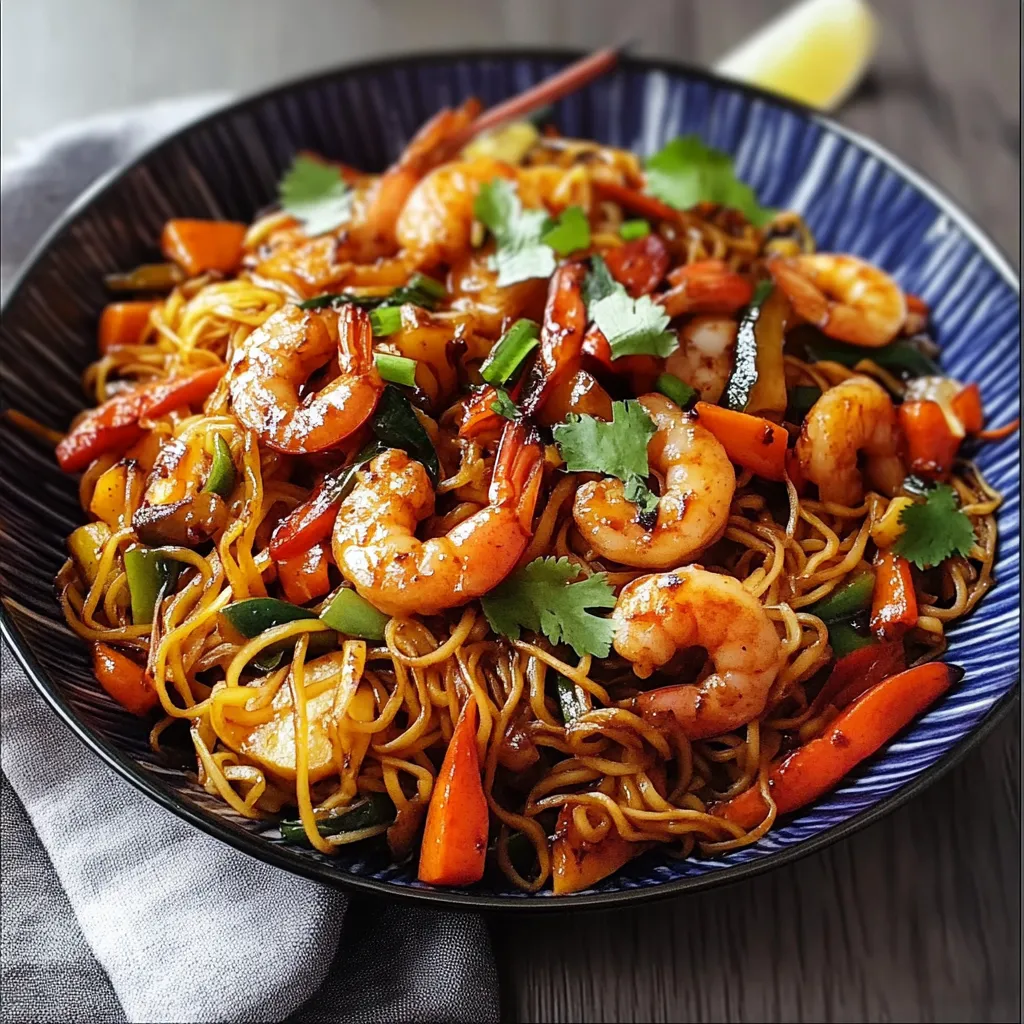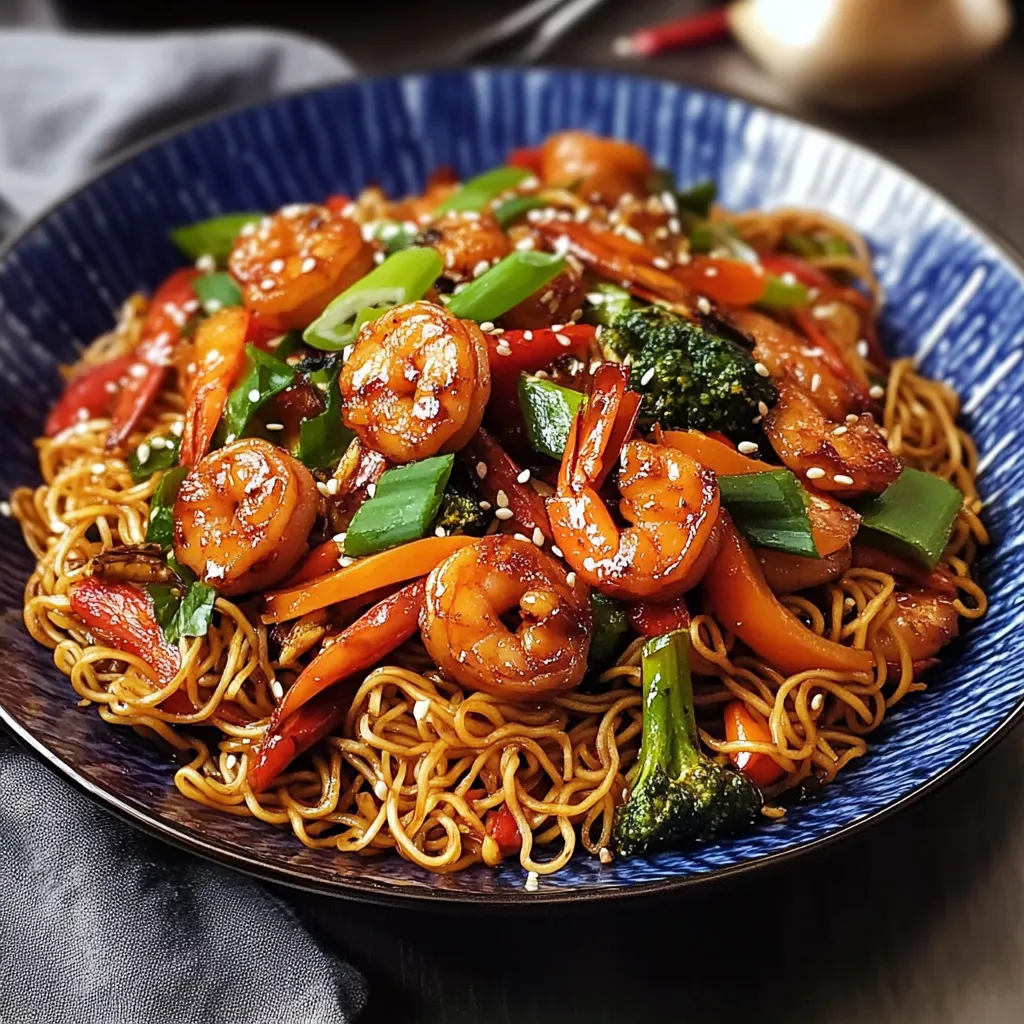 Pin
Pin
This quick stir-fried noodle dish transforms simple ingredients into a restaurant-worthy meal in just 20 minutes. The combination of tender shrimp, crisp vegetables, and silky noodles bathed in a savory-sweet sauce creates the perfect balance of flavors and textures that makes Chinese cuisine so beloved worldwide.
I developed this recipe during my years of apartment living when takeout was tempting but my budget was tight. After many attempts to recreate my favorite restaurant dish, this version finally earned my Chinese neighbor's approval, which felt like winning a culinary gold medal.
Ingredients
- Chinese egg noodles or rice noodles: Foundation of the dish, choose egg noodles for a richer taste or rice noodles for a gluten free option
- Shrimp: Adds sweet protein that cooks quickly, look for wild caught for best flavor
- Vegetable oil: Neutral flavored oil with high smoke point ideal for stir frying
- Garlic and ginger: Aromatic base that defines authentic Chinese cooking, use fresh not powdered
- Carrots, red bell pepper and cabbage: Provide color crunch and nutrition, slice thinly for quick cooking
- Bean sprouts: Add signature crunch and freshness, add these at the end to maintain texture
- Green onions: Provide mild onion flavor and beautiful garnish, use both white and green parts
For the sauce
- Soy sauce: Provides umami and salt, use low sodium if watching salt intake
- Oyster sauce: Adds complex sweetness and depth, authentic brands contain real oyster extract
- Sesame oil: Aromatic finishing oil that should never be cooked, just a little goes a long way
- Rice vinegar: Adds brightness and balance, don't substitute with other vinegars
- Sugar: Balances the savory elements, can substitute with honey
- White pepper: Traditional in Chinese cooking with a different flavor profile than black pepper
Step-by-Step Instructions
- Prepare the noodles:
- Cook noodles according to package directions but undercook them slightly by about one minute as they will continue cooking in the wok. After draining, rinse immediately under cold water to stop the cooking process and prevent sticking. Toss with a few drops of oil if not using right away.
- Make the sauce:
- Combine all sauce ingredients in a small bowl, stirring until sugar is completely dissolved. Taste and adjust seasoning if needed. The sauce should be balanced between salty, sweet and tangy. Having this ready before cooking is essential as the stir frying process moves very quickly.
- Cook the shrimp:
- Heat your wok or large skillet until it is very hot then add one tablespoon oil. The oil should shimmer but not smoke. Add shrimp in a single layer and cook undisturbed for 30 seconds before stirring. Cook just until they begin to curl and turn pink with some translucency still in the center as they will cook more later. Remove to a plate to prevent overcooking.
- Stir fry aromatics:
- Add remaining oil to the hot wok and immediately add garlic and ginger. Keep them moving constantly to prevent burning while allowing their flavors to infuse the oil. This should take only about 30 seconds until you can smell their fragrance.
- Add vegetables:
- Start with the firmest vegetables carrots and peppers that need longer cooking time. Maintain high heat and keep everything moving rapidly. After two minutes when they begin to soften add the cabbage or bok choy which needs less time. The vegetables should remain crisp tender with vibrant colors.
- Combine noodles and sauce:
- Add the prepared noodles to the wok spreading them out to maximize contact with the hot surface. Pour the sauce evenly over the noodles and toss everything together using tongs or two spatulas with a lifting motion to combine thoroughly without breaking the noodles.
- Final integration:
- Return the partially cooked shrimp to the wok along with bean sprouts and most of the green onions reserving some for garnish. Toss everything gently but thoroughly for about one minute until the shrimp are fully cooked and everything is evenly coated with sauce and heated through.

The secret to this dish is getting your wok truly hot before adding ingredients. I learned this from my grandmother who would test her wok by sprinkling a few drops of water on the surface. If they instantly evaporate with a sizzle, the wok is ready. This technique transformed my stir fries from soggy to restaurant quality.
Wok vs. Skillet
While a traditional carbon steel wok is ideal for this recipe because of its high sides and even heat distribution, don't worry if you don't own one. A large cast iron or stainless steel skillet works perfectly fine. The key is using a pan large enough to allow ingredients to be tossed without spilling over. If using a flat skillet, you may need to stir more frequently rather than using the traditional tossing motion of wok cooking.
Vegetarian Adaptation
This recipe easily converts to vegetarian or vegan by making a few simple swaps. Replace shrimp with firm tofu pressed and cubed, or use tempeh for a heartier texture. Substitute vegetarian oyster sauce which is typically made from mushrooms or simply use more soy sauce with a pinch of sugar to compensate for the sweetness. Adding sliced shiitake mushrooms will enhance the umami flavor that seafood typically provides.
Sauce Variations
The sauce recipe provided creates a classic Chinese brown sauce, but you can easily modify it to create different flavor profiles. For a spicier version, add sambal oelek or sriracha to taste. For a sweeter sauce reminiscent of lo mein, increase the sugar to one tablespoon. If you enjoy Thai flavors, add a tablespoon of peanut butter and lime juice to create a hybrid dish. Remember that the sauce should be slightly stronger than you think necessary as it will be distributed throughout all ingredients.
Common Questions About This Recipe
- → What noodles are best for stir-frying?
Chinese egg noodles or rice noodles work best as they hold their texture and absorb sauces well during stir-frying.
- → Can I use other proteins instead of shrimp?
Yes, you can substitute shrimp with chicken, tofu, or beef for similar results. Adjust the cook time accordingly.
- → How do I prevent the noodles from sticking together?
Rinse the cooked noodles under cold water, drain well, and toss them with a bit of oil before stir-frying.
- → Can I make this dish vegetarian?
Yes, simply replace shrimp with tofu or more vegetables, and use vegetarian oyster sauce or omit it.
- → What vegetables can I add or swap in this dish?
You can add broccoli, snow peas, mushrooms, or zucchini to customize the recipe with your favorite vegetables.
- → How do I store leftovers?
Store leftovers in an airtight container in the refrigerator for up to 3 days. Reheat in a pan or microwave before serving.
